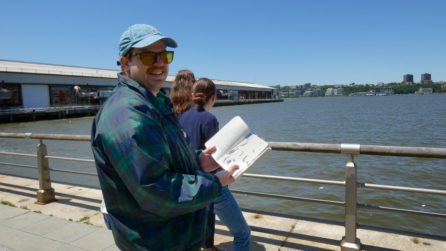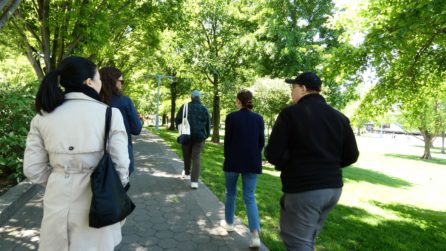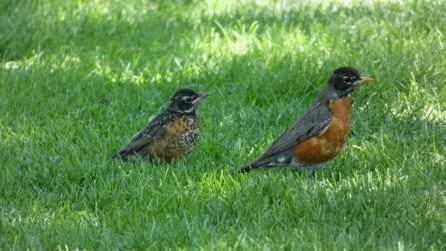Staff Spotlight: NYSCF’s Andrew Reiter Wants You To Know How Majestic Pigeons Are
NewsPigeons: they are the little airborne city dwellers who eat crumbs and nest in unexpected places. Some people love them, others not so much. NYSCF Administrative & Recruiting Coordinator Andrew Reiter has been a bird enthusiast his whole life and wants you to know that pigeons are more majestic than you might think. In fact, New York City is full of birds that can capture your attention and imagination if you just let them.
Andrew is NYSCF’s resident ‘bird connoisseur’ who people go to for bird facts, advice, and even immersive bird walks outside the office. He has recently led a couple of bird walks for NYSCF staff in the nearby Hudson River Park. We sat down with Andrew to learn more about his passion for birds, how this influences his role at NYSCF, and why your least favorite birds (whether geese or pigeons) are misunderstood.
When did you first become interested in birds?

I’ve been interested in birds since I was very little. The lore is that I was really into rubber ducks and would take them everywhere with me. So my parents decided to take me to see real ducks and I loved it. I started reading books about birds, bird watching, drawing birds, probably acting like a bird. It was all-consuming. And I think a lot of people have obsessions like that when they are little, but mine stuck around.
Did you have pet birds growing up?
Yes – my first pet bird was a budgie, like a parakeet, named KK, a name that didn’t really mean anything. I was just five years old and liked the sound of it. And then I had a cockatiel after that. As a teenager I started raising chickens. I got a bunch of baby chicks and raised them from birth. There’s still one left at my parents’ house who is 13 years old now! Raising chickens was like the joy of my life, and now I’m in my pigeon era.
Pigeons can be pets?
Yes! All the pigeons in New York are descendants of domestic pigeons brought over by colonists. They aren’t native to the Americas. They’ve been domesticated by people for more than a thousand years. And that’s why they’re not scared of us and are so comfortable nesting on buildings.
The Wild Bird Fund, where I volunteer, has a lot of pigeons that are either non-releasable feral pigeons who have a health complication like lead poisoning or blindness, but also a lot of domestic pigeons that presumably belonged to a fancier or someone who races pigeons and got separated from their flock and ended up on the street. So these are pet pigeons that don’t have wild instincts. There are also a type of pigeon called ‘king pigeons’ that are raised for meat and then are released from or escape slaughterhouses in Brooklyn and Queens. It’s pretty common for pigeons to end up in animal shelters.
So there are tons of pigeons that need homes, and there are some organizations that are dedicated just to pigeon rescue and adoption. There’s not much demand for having a pet pigeon, which is too bad because they make excellent pets.
What are your pigeons like?
I have two pigeons that I adopted from the Wild Bird Fund. One is named Rumble and the other is named Jan. Jan originally belonged to another person who had adopted pigeons and took her in after she kept landing on people’s heads in the city, but she was kind of breaking up the ‘marriage’ between two pigeons that lived there already. She was a bit of a homewrecker, so she came to live with me.
Rumble was surrendered to the Wild Bird Fund by someone who could no longer keep her as a pet, so she doesn’t have many typical bird instincts, and she had already learned to imprint on people. She’s kind of a diva, and mildly mercurial. She is either obsessed with me or wants to kill me. She can sometimes be a bully to sweet, simple Jan. But I love her all the same. I can see her right now staring at me from her nest wondering why I’m not paying attention to her.
What are you teaching in your bird walks for NYSCF staff?

The bird walks are really fun – we stroll around the streets and parks outside the office, and you can actually see a bunch of different birds. I’m used to doing nature walks for kids, but this is the first time I’ve done it for adults, and it has been very rewarding. Everyone has been so engaged, although I don’t think I convinced anyone to like seagulls.
I love spreading the joy of the natural world and cultivating the sense of wonder that lives in all of us. Birds are a really accessible entry point into that because they are everywhere, and as soon as people start paying attention to them, they realize how ubiquitous they are. They’re easy to see and hear – they share their gifts with us, we just have to be open to receiving them.
What are the different birds around New York City that one can see?
There’s a ton: I was shocked when I moved here. New York City is located on the Atlantic flyway, which is an ancient migration path where basically all the birds on the East coast funnel through each Spring and Fall. So we get really exciting birds here: songbirds like warblers and orioles, as well as shore birds and birds of prey. They come in really concentrated numbers, and because of the architecture of New York, they often take refuge in the parks, so you can see a lot there. There’s more than 200 species of birds in New York City – a lot more than people realize!
What would you recommend for someone interested in getting into birding?
The best way to start is just by looking around where you live and noting the birds you see. There’s also a lot of resources for those interested in getting more involved. New York City Audubon is really keen on making birding more inclusive, especially for people who haven’t traditionally had access to the outdoors, like those who are disabled or in low-resource communities. They are really trying to break down those barriers, and in doing so, they are making birding more accessible for everyone.
The Cornell Lab of Ornithology has a really cool app called Merlin that is like shazam for bird calls. And if you upload photos, it will tell you what kind of bird you saw.
What is your favorite kind of bird?
It’s actually chickens! I love all birds, but members of the chicken family (like pheasants, turkeys, and quail) are so cool to me. And obviously I love pigeons. I’ve always been a little drawn to birds with bad reputations: vultures, gulls, geese. I think geese are super misunderstood. They’re such good parents – they are super protective and alert. They won’t hesitate to go after anyone who is threatening their goslings. I think if they weren’t birds, people would find those qualities really endearing.
If someone in New York comes across like an injured bird on the street, what should they do?

In New York we have the Wild Bird Fund, and we’re so fortunate to have this organization because they will take any kind of injured bird. And there are unfortunately a lot of ways for birds to get injured in the city, with the combination of light pollution and bird-unfriendly architecture. They often crash into windows and end up on the ground stunned.
What I do is carry around a couple of brown paper bags with me because they are kind of the perfect bird ambulances: they are lightweight, soft, and easy to find. So you can always take a bird to the Wild Bird Fund on the Upper West Side, or you can reach out to New York City Audubon and they will send one of their volunteers to pick it up.
And if you find a dead bird, you can also report that on a site called dbird.org. You can submit a photo so they know what kind of bird it was. They use that information to figure out where in the city are most dangerous for birds and where we should be allocating resources.
Have your various bird adventures informed your work at NYSCF?
I’m so lucky to work with a lot of incredible people throughout the NYSCF community, and many have been so eager to learn about birds and the natural world. And now people come to me to show me baby birds they found in their yard or starlings on a rooftop or things like that. Folks here are very open to sharing their passions with one another, which is important not only for science, but for life. It’s so rewarding to see curiosity bloom within everyone.